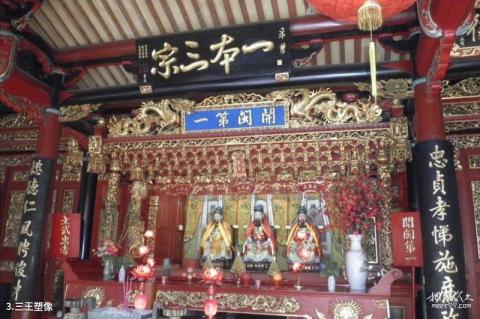
Introduction to the statues of the Three Kings: The stone pillars on both sides of the ancestral hall are carved with three pairs of couplets praising the achievements of the Three Kings in opening up Fujian and regulating springs. The lamp beams and pine beams are carved with lions, the beams and columns are carved with patterns, and the brackets are decorated with flowers and trees, all of which preserve the original building components. There is a magnificent carved niche in the center of the hall, in which statues of Wang Chao, Wang Shengui and Wang Shenzhi are enshrined. In 885 AD, three brothers, Wang Chao, Wang Shengui and Wang Shenzhi, led a peasant uprising army into Fujian in Gushi County, Guangzhou, Henan, unified Fujian, and established the country of Fujian. They are known in history as the "Three Kings who opened Fujian". The front beam of the ancestral hall hangs a plaque inscribed by former Singaporean Prime Minister Wang Dingchang with the title "The First in Opening Fujian". The back beam hangs one of Song Mifu's handwritings "One Book and Three Sects" and a plaque inscribed by Wang Jinping, a well-known Taiwanese, with the title "Guang Qian Yu Hou". The overall setting is Solemn and solemn. In the gallery on the west side of the stone cairn outside the main temple, there are 12 bluestone shadow sculptures of "Historical Paintings of the Three Kings of Fujian in the Five Dynasties" embedded in them, which reproduce the historical achievements of the "Three Kings".
